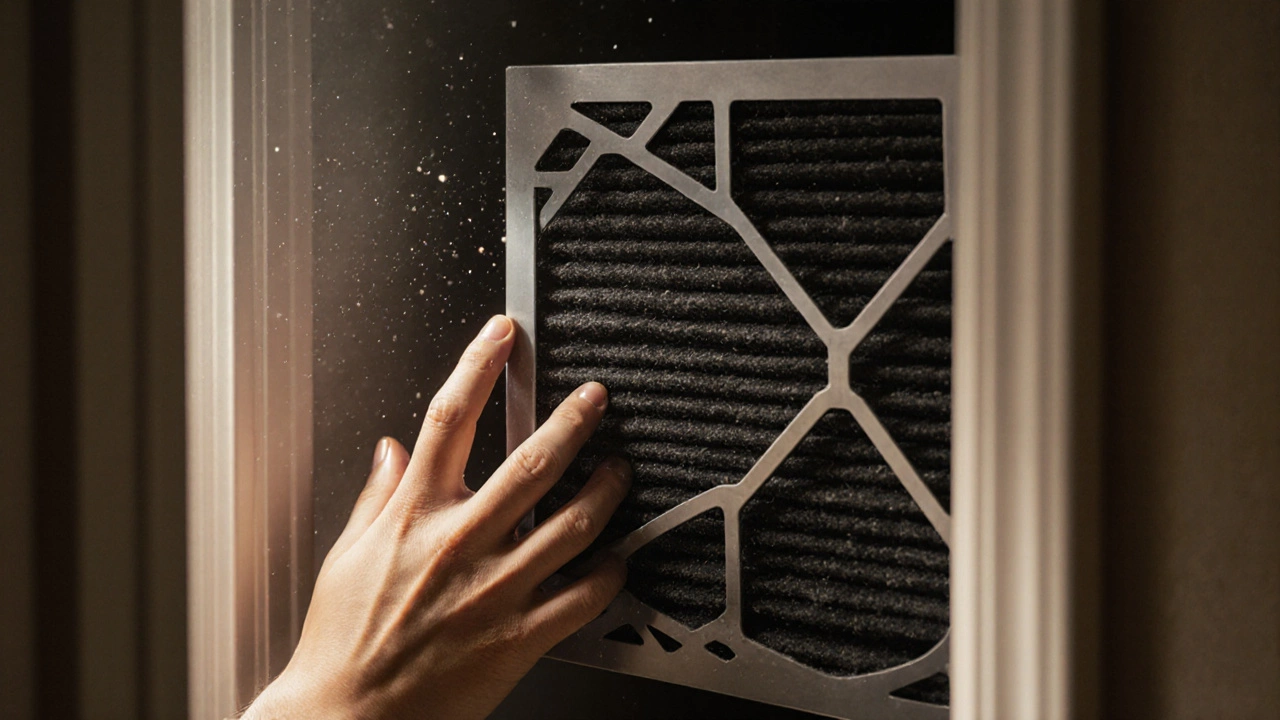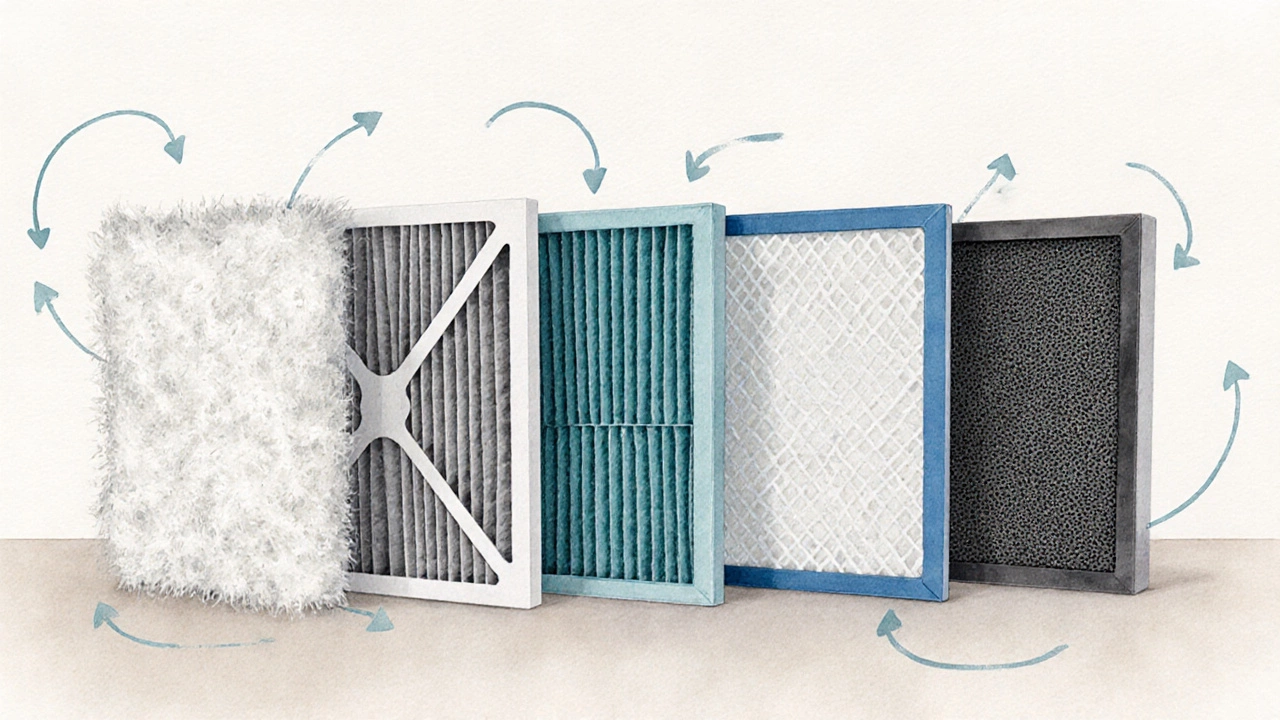 Oct, 21 2025
Oct, 21 2025
Air Filter Replacement Calculator
Recommended Replacement Interval
Important: Check filter monthly for visible debris and reduced airflow.
Key Takeaways
- Most residential filters last 3‑6 months, but high‑efficiency models can go up to 12 months.
- Pets, smoking, and high dust environments shorten filter life.
- Check the filter monthly for discoloration or visible debris.
- Follow the manufacturer's recommended MERV rating for optimal airflow and efficiency.
- Replace the filter promptly to keep energy bills low and indoor air quality high.
When you hear the term Whole‑house air filter is the primary filter that sits inside your home’s heating, ventilation, and air‑conditioning (HVAC) system, you might wonder how often you actually need to swap it out. The answer isn’t a one‑size‑fits‑all number; it depends on the filter type, your home’s occupancy, and the air quality you aim for. Below you’ll find a practical roadmap that lets you decide the right interval without guessing.
What Drives Filter Lifespan?
Three main factors dictate when a filter should be replaced:
- Filtration rating - The higher the MERV rating (Minimum Efficiency Reporting Value, a metric from 1 to 16 that measures how well a filter captures particles), the more particles it catches, which can cause it to clog faster.
- Environmental load - Homes with pets, smokers, or nearby construction produce more dust and lint. Seasonal pollen spikes also raise the particle count.
- System usage - Running the HVAC system continuously (common in extreme climates) pushes more air through the filter, accelerating wear.
Typical Replacement Intervals by Filter Type
| Filter Type | MERV Rating | Typical Lifespan | Best For |
|---|---|---|---|
| Fiberglass (Disposable) | 1‑4 | 30‑90 days | Budget‑conscious homes with low air‑quality demands |
| Pleated (Standard) | 5‑8 | 3‑6 months | Average households, pet owners |
| High‑Efficiency Pleated | 9‑12 | 6‑12 months | Allergy sufferers, high‑dust environments |
| HEPA | 13‑16 | 12‑18 months | Medical facilities, homes with severe asthma |
| Carbon (Activated Charcoal) | Varies (usually 5‑8) | 6‑12 months | Odor control, smoke‑free homes near traffic |

How to Tell If It’s Time for a New Filter
Even if you’re on a schedule, a visual check saves money and prevents system strain. Look for these signs:
- Filter media has turned dark gray or black.
- Airflow feels weaker - rooms take longer to reach the set temperature.
- Higher utility bills without a change in usage.
- Increased dust on surfaces or a stale smell.
When any of these appear, swap the filter immediately, regardless of the calendar.
Step‑by‑Step Replacement Guide
- Turn off your HVAC system (the heating, ventilation, and air‑conditioning equipment that circulates air throughout your home) to avoid pulling debris into the ducts.
- Locate the filter slot - typically behind the return air grille or inside the furnace plenum.
- Slide the old filter out. Note the airflow direction arrows printed on its frame; you’ll need them for the new filter.
- Insert the new filter, matching the arrows to the direction of air flow.
- Secure the grille, turn the system back on, and log the change date in a home‑maintenance notebook or phone reminder.
Choosing the Right MERV Rating
Professional guidelines from ASHRAE (American Society of Heating, Refrigerating and Air‑Conditioning Engineers, which publishes standards for indoor air quality) suggest that residential systems operate best with MERV 8‑13 filters. Going above MERV 13 can restrict airflow unless your blower motor is sized for higher resistance. The U.S. DOE (Department of Energy, which sets energy‑efficiency guidelines for appliances) recommends checking your system’s manual before selecting high‑efficiency filters.
Cost vs. Benefit: When to Upgrade
Fiberglass filters cost as little as $5 but need frequent changes, while a 12‑inch HEPA unit can run $80‑$120 per filter but last a year. Calculate the breakeven point by multiplying filter cost by the number of replacements per year and comparing that to potential energy savings (usually 5‑15% lower HVAC load). If you have asthma or severe allergies, the health benefit often outweighs the extra dollar.
Checklist for Ongoing Filter Management
- Mark the replacement date on your calendar immediately after installing a new filter.
- Inspect the filter monthly during season changes (spring, fall).
- Keep spare filters of the same size and MERV rating in a garage or utility closet.
- Consider a digital filter monitor (a sensor that measures pressure drop across the filter and alerts you via smartphone) for high‑usage homes.
- When upgrading, verify that your HVAC blower motor can handle the chosen MERV rating (consult the installer if unsure).
Frequently Asked Questions
How often should I replace a standard pleated filter?
Most 5‑8 MERV pleated filters last 3‑6 months in average homes. If you have pets or live in a dusty area, aim for the 3‑month mark.
Can I wash and reuse a disposable filter?
No. Washing damages the filter media and reduces its efficiency. Use a washable, “re‑usable” filter specifically marketed for that purpose.
What signs indicate my filter is clogged?
Reduced airflow, higher energy bills, visible dust buildup on the filter, and a noticeable musty odor are clear indicators.
Does a higher MERV rating always mean better air quality?
Higher MERV filters capture smaller particles, but they can also restrict airflow if the HVAC blower isn’t rated for it. Choose the highest MERV your system can handle without sacrificing efficiency.
How does a carbon filter differ from a HEPA filter?
Carbon filters target gases and odors using activated charcoal, while HEPA filters trap microscopic particles (0.3 microns) but do little for smells.
By following the schedule that matches your home’s conditions and by staying alert to the visual cues, you’ll keep your whole house air filter replacement on point, save on energy costs, and breathe easier.